The winner – Mailchimp
Life-changing superhero
In this comparison, Mailchimp wins seven out of eleven rounds. Two rounds end in a tie, and there are aspects where tinyEmail outperforms Mailchimp. Continue reading to learn about the cases where Mailchimp outperforms tinyEmail and why.
What Mailchimp features are better than Mailerlite?
- Getting started experience
- Marketing automation
- Customer segmentation capabilities
- Ecommerce analytics
- Compatibility with other marketing channels and integrations
- Unconventional credit card approach
- Automation available for Shopify users only. Very basic.
- Basic-level segmentation
- Basic-level analytics
- There is no SMS and other marketing channels incorporated
Despite the rise of new marketing channels, email marketing continues to be an effective strategy in 2024. One evidence of this is the ongoing emergence of new email marketing tools.
Take tinyEmail, for instance. Established in 2021, this platform offers a simplified approach to email marketing. It comes equipped with a robust email builder and an extensive collection of templates.
However, if you seek alternatives, Mailchimp is worth considering. Founded in 2001, Mailchimp has evolved into an all-in-one marketing solution with an extensive feature set over the years.
Choosing between tinyEmail vs Mailchimp, it really boils down to your requirements and budget. You should weigh factors like user-friendliness, design capabilities, automation functionalities, and cost when making your choice.
In this article, we’ll thoroughly compare both platforms, considering these aspects and more.
Let’s dive in.
tinyEmail vs Mailchimp: Quick overview
Mailchimp holds a rating of 3.5/5 on the Shopify App Store, with users valuing its user-friendliness and robust customer support.
The platform boasts powerful automation features and provides diverse pricing options. Nevertheless, some users have raised worries regarding “hidden fees” and inflated costs.
tinyEmail, on the other hand, boasts a much higher rating of 4.7/5 on the Shopify App Store. Most users appreciate the platform’s ease of use and its smooth navigation.
So which tool’s right for you — tinyEmail or Mailchimp? It’s probably too soon to tell.
Let’s look at the key differences between these platforms, followed by an in-depth Mailchimp vs tinyEmail comparison.
It’s evident that Mailchimp provides a more extensive feature set compared to tinyEmail. However, this doesn’t necessarily mean that we dismiss tinyEmail altogether.
For more clarity, let’s delve deeper into the details.
tinyEmail vs Mailchimp comparison: Feature by feature
Whether your preference leans towards tinyEmail or Mailchimp, both options can enhance your email marketing campaigns.
However, one of these tools will better suit your particular requirements. Find out which one that is by delving deeper into the details.
Ease of getting started
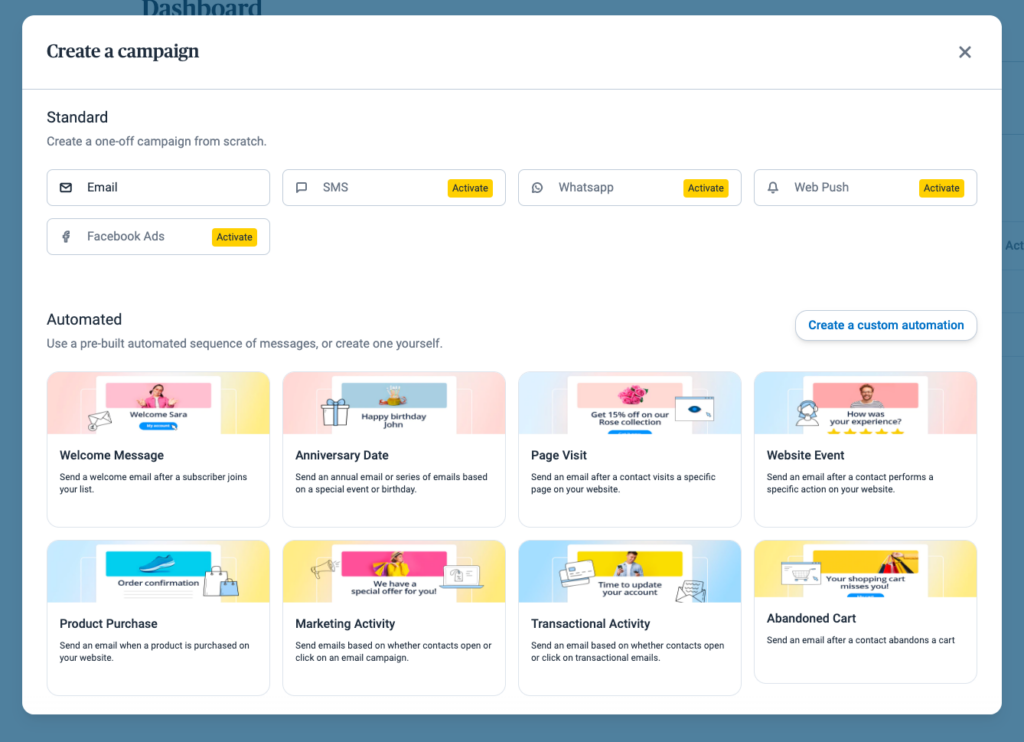
Getting started with Mailchimp is a user-friendly and straightforward process. The platform offers a helpful checklist to guide users through the setup, along with a generous 30-day free trial to explore its features.
tinyEmail offers a 7-day free trial with seamless account verification and user-friendly settings. Its usability aligns closely with Omnisend and MailerLite, delivering an intuitive user experience with a modern and clear design.
However, note that tinyEmail’s signup process demands more initial information compared to other platforms.
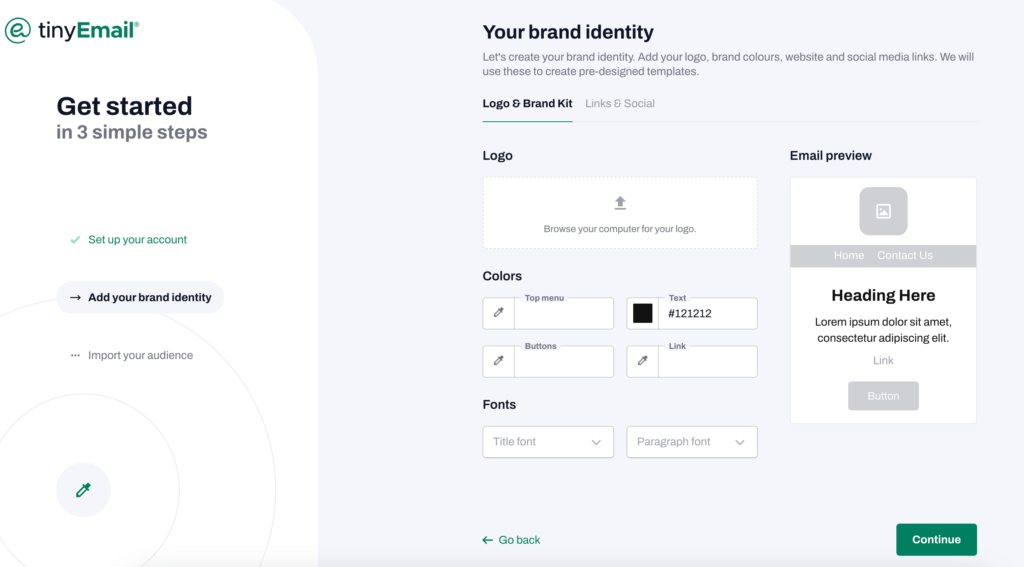
Moreover, an unusual aspect is that when you begin tinyEmail’s free trial, you’re prompted to provide credit card information. There’s no option for selecting a free plan; only paid plans are offered.
Subsequently, tinyEmail follows up with an email allowing signup without credit card details. We found this approach to be a bit fishy.
Mailchimp, like tinyEmail, requests credit card information, but they are upfront about it from the beginning.
However, one drawback is that due to the extensive range of features Mailchimp provides, certain functions can be difficult to find. We also encountered issues when attempting to change the sender’s email address.
Mailchimp emerges as the winner, despite some navigation challenges, thanks to its comprehensive guidance. In contrast, tinyEmail’s unconventional credit card approach raises trust issues among users.
Building an email campaign
tinyEmail and Mailchimp provide reliable email campaign builders, each with distinctive features.
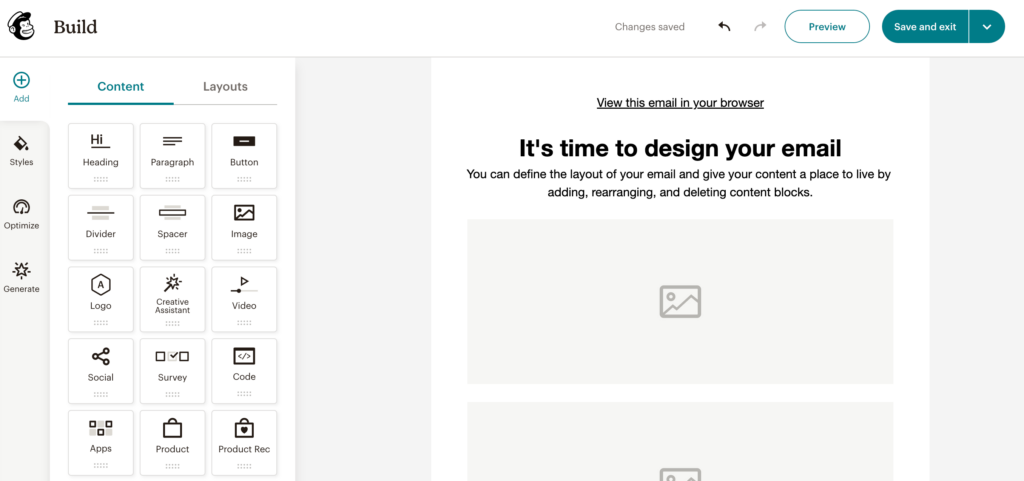
Mailchimp provides users with two email builders: the classic version and the new builder (currently in beta). These builders are intuitive and offer a wide range of features.
Additionally, Mailchimp supports various email campaign types, such as A/B tests and RSS campaigns.
In contrast, tinyEmail only offers regular email campaigns, lacking advanced campaign types. However, its email builder excels in various aspects, offering:
- Lots of flexibility with elements like timers and image carousels
- A stock image library for visuals
- An AI text generator for email copy
- 300+ templates for different occasions
- Several fonts and styles for customization
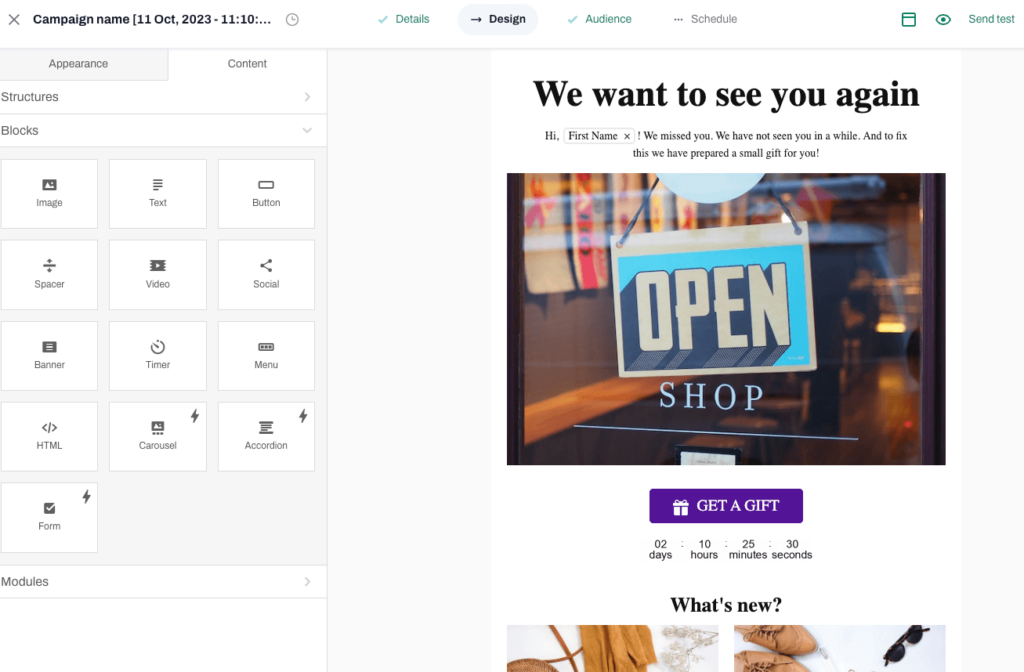
While tinyEmail offers various functionalities, no dedicated content block exists for creating Smart Elements and Product Cards. In general, the platform lags behind when it comes to ecommerce-focused features.
Moreover, it’s odd that while some templates adapt to your brand design, others don’t.
Similar to tinyEmail, Mailchimp offers good-looking templates for email campaigns. Additionally, it provides the flexibility to work with blank templates for those seeking more control over their email design.
However, it’s worth noting that the templates on Mailchimp’s free plans are rather restricted. There are just six options to pick from, and even those appear basic.
When it’s personalization in question, tinyEmail provides merge tags. On the other hand, Mailchimp offers dynamic content blocks, although this is a bit challenging to use without Knowledge Base.
Mailchimp further sweetens the deal by letting users:
- Send postcards
- Create surveys
- Receive subject line recommendations
- Preview emails on different devices
Mailchimp takes the lead again, thanks to its support for a broader range of email types and robust feature set.
Marketing automation
In this segment of the tinyEmail vs Mailchimp comparison, we’ll examine both tools’ automation capabilities.
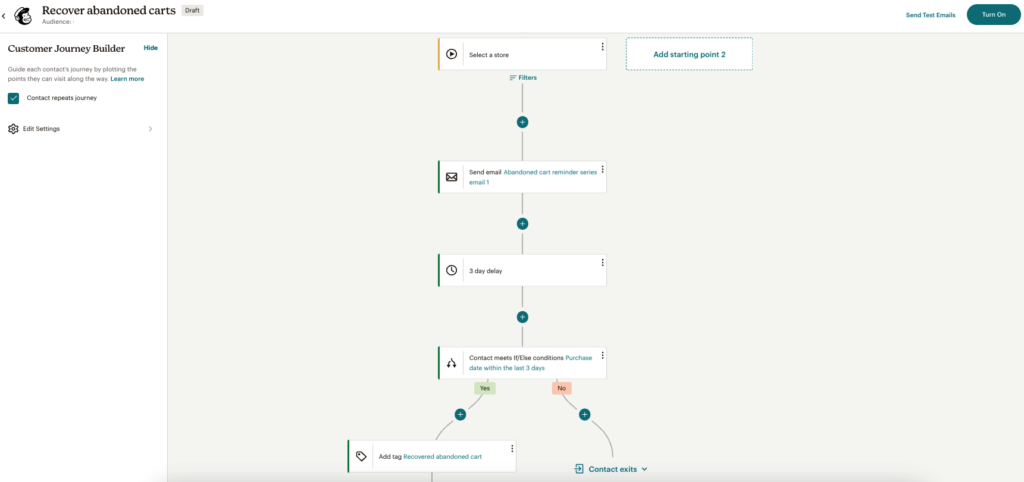
While both platforms provide intuitive automation editors, Mailchimp outshines tinyEmail yet again. Let’s find out why:
- Pre-built workflows: Mailchimp offers 70+ pre-built customer journey templates, including social media channels and email sequences. In comparison, tinyEmail’s templates are limited and primarily designed for Shopify users. They focus on scenarios like abandoned carts, thank-you messages, and product reviews.
- Triggers: Mailchimp provides numerous built-in triggers based on various events and actions. In contrast, tinyEmail doesn’t offer triggers, limiting its automation capabilities.
- Analytics: Mailchimp’s Classic Automation Reports provide an extensive range of statistics, including campaign statuses, queue numbers, and insights into deleted automation emails. On the contrary, tinyEmail’s analytics for automated journeys are limited.
- Integrations: Mailchimp integrates with social media platforms like Facebook, Instagram, and Twitter, enhancing cross-channel marketing. tinyEmail lacks support for integrating additional marketing channels into its workflow.
What’s worse, with tinyEmail, you can only activate the provided automation flows without any custom logic or edits.
Mailchimp clearly takes the lead in this round, surpassing tinyEmail in every aspect. tinyEmail automation is suitable for the very beginners.
Signup forms and landing pages
Mailchimp and tinyEmail both have room for improvement in their list-building capabilities. However, each has its strengths and weaknesses, so your choice will depend on your specific needs.
Let’s start with tinyEmail. The platform lets users create different types of signup forms. These include embedded forms, popups, and flyouts.
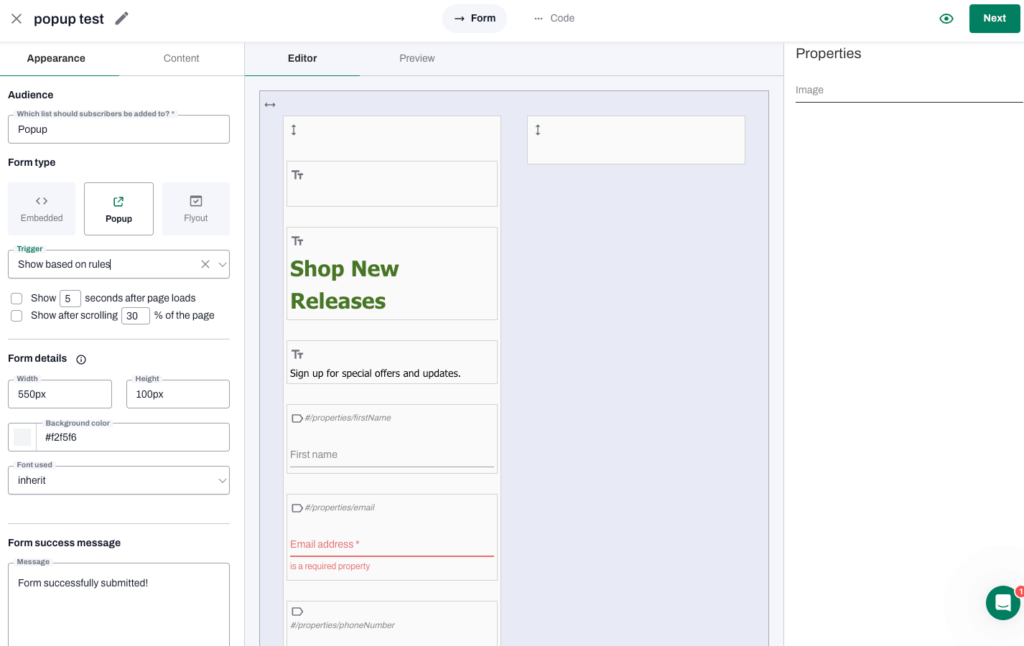
While the forms in tinyEmail are appealing, their adjustability is somewhat limited.
Users may find the editor to be less intuitive, with challenges in adding or changing suggested images. Moreover, you need to manually add forms to your website source, as they don’t launch automatically.
The settings for form customization are also constrained, making tinyEmail less flexible.
What’s more, tinyEmail doesn’t offer landing pages at all. This can be a significant limitation, especially for ecommerce businesses.
Mailchimp, on the other hand, boasts one of the best landing page editors in town. It comes with nine customizable templates that can easily be tailored.
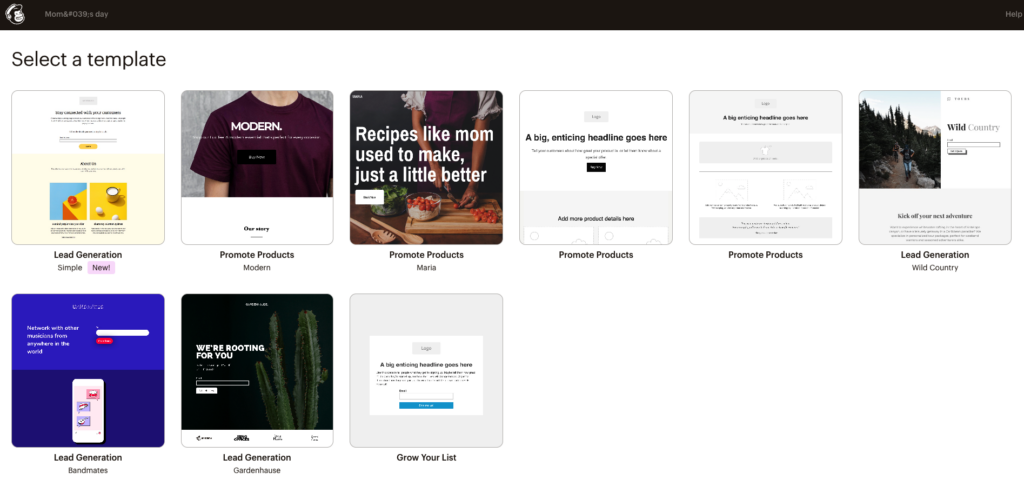
Surprisingly, though, Mailchimp is missing pre-designed signup form templates entirely. This is a considerable drawback.
Furthermore, analytics of signup form performance is pretty basic in Mailchimp. However, this may not seem so bad when compared to tinyEmail, which doesn’t offer performance reporting for signup forms at all.
List management
List management in tinyEmail is straightforward. It offers key insights into your audience’s composition, specifically where your subscribers are coming from. Beyond this, the depth of audience insights is limited.
Mailchimp provides convenient subscriber tagging and segmentation for managing lists.
However, it’s rather disappointing that the tool segregates lists. This means that you end up paying for duplicate email addresses, including unsubscribed and inactive contacts.
Mailchimp wins by a slight margin. tinyEmail needs landing page functionality, and more flexibility in editing signup forms.
Segmentation
tinyEmail vs Mailchimp: Who takes the lead in segmentation?
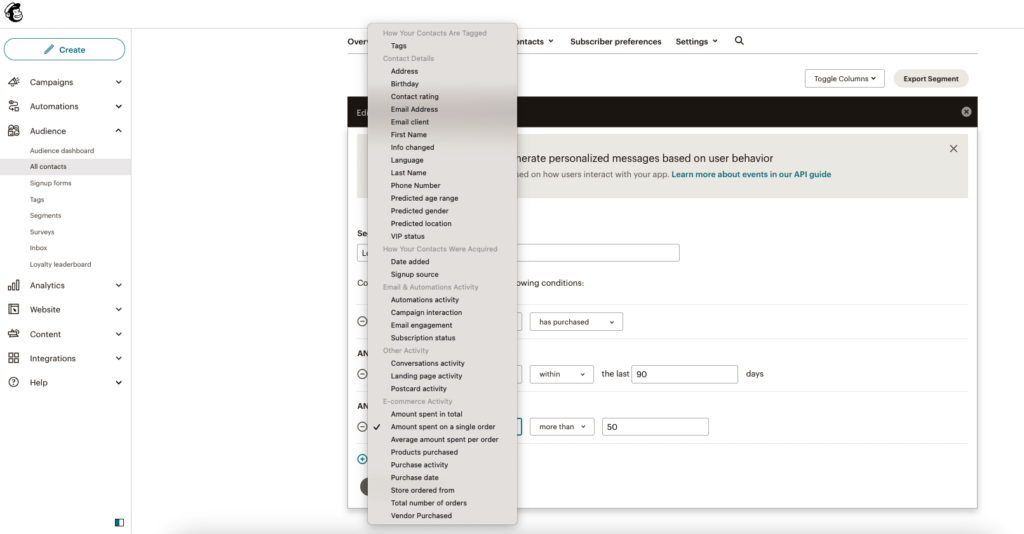
Mailchimp provides three pre-built audiences to get you started, allowing for immediate segmentation. Moreover, you can personalize these segments by incorporating up to five conditions for each.
If you own an ecommerce business, you’ll benefit from Mailchimp’s segmentation options. It offers options based on:
- Purchase history
- Order value
- Specific product categories
Now, let’s check how tinyEmail’s segmentation features compare.
The tool comes with 15 pre-defined segments. However, only four are accessible with the Standard plan, and the rest are exclusively for Pro plan users.
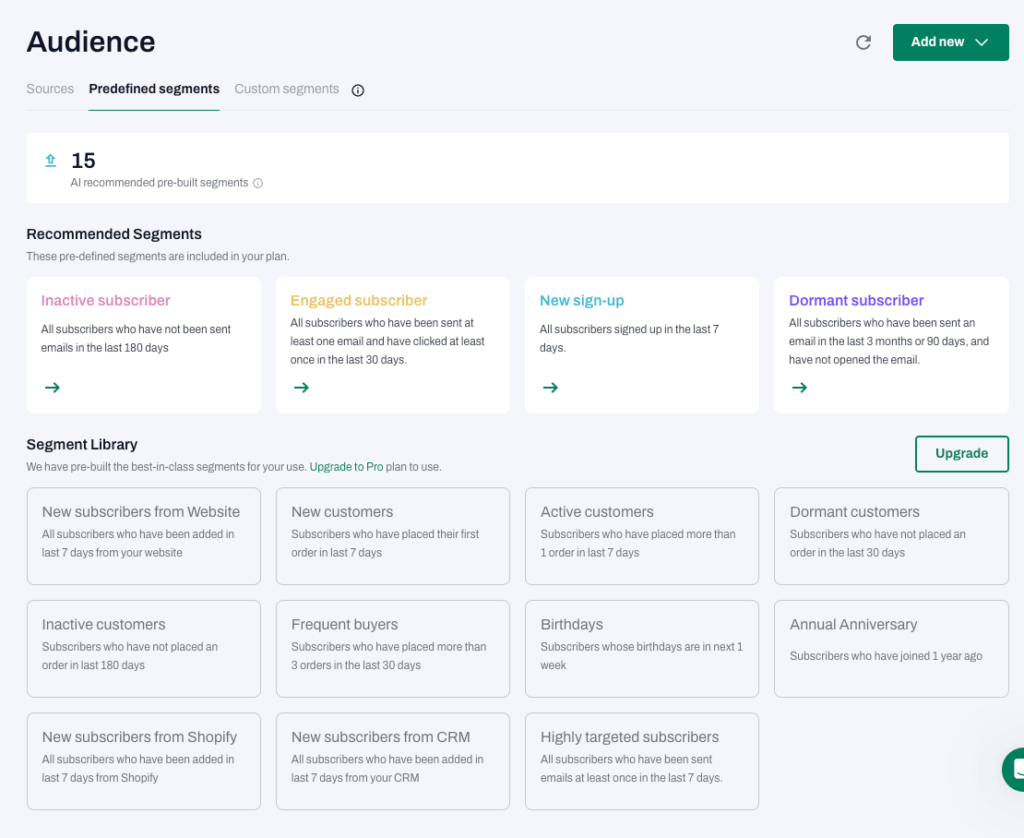
Within tinyEmail, you can segment your audience using email engagement criteria. Moreover, you can create segments based on subscriber profile information, including factors like location, name, order count, and their most recent order.
tinyEmail’s segmentation tools offer a decent range of options, but they lack advanced features that could benefit ecommerce businesses. For instance, there are no conditions based on on-site behavior or tags.
Mailchimp takes the lead in this round. Although it might require a bit more learning, it offers a wider range of segmentation options.
Analytics
tinyEmail vs Mailchimp: Which platform excels in the analytics department?
Mailchimp provides a diverse range of analytical metrics to track, including but not limited to:
- Email opens and clicks
- Social media interaction and engagement
- Landing page performance
- Monthly email campaign effectiveness
Analytic metrics within tinyEmail are similar, offering visibility into opens, clicks, and delivery rates. Additionally, you can monitor the performance trends of your email campaigns.
For Shopify users, there’s a convenient method to track sales generated from email campaigns. They can also view a list of email links along with the click counts they’ve received.
That said, tinyEmail needs to catch up compared to Mailchimp’s advanced reporting features.
For instance, Mailchimp lets users export data for a specific audience within a defined time frame. Moreover, its website report reveals data about unique anonymous visits and the number of subscribers acquired as a result.
Mailchimp’s Premium plan users also have access to comparative reports.
Nonetheless, neither of the platforms provides extensive insights tailored for ecommerce businesses. Additionally, tinyEmail lacks geolocation reports and signup form analytics.
Mailchimp outperforms tinyEmail by offering more in-depth insights.
Customer support
tinyEmail provides chat and email support 24/7.
Also, tinyEmail does offer a range of online resources and tutorials for those comfortable with a do-it-yourself approach. However, these resources may not be as extensive as on other platforms, potentially leaving some questions unanswered.
On a positive note, tinyEmail offers onboarding calls, which often resolve many inquiries at the very beginning of your journey.
Regarding Mailchimp, the level of customer support differs depending on the plan.
- Free plan: Email support for the first 30 days
- Paid plans: 24/7 email and chat support
- Premium plan: Priority support via email, chat, and phone
In our assessment, we tested Mailchimp’s live chat support, which proved to be very responsive.
Like tinyEmail, Mailchimp offers a content hub filled with valuable resources. The Mailchimp 101 tutorial is a useful resource for better understanding the tool. They also offer blog articles, categorized resources, and multilingual YouTube videos.
We think that tinyEmail tries harder to provide excellent customer support.
Integrations
Mailchimp boasts an extensive library of 300+ integrations across diverse categories. These include ecommerce platforms, CRM software, design and content tools, developer tools, and more.
tinyEmail also provides lots of integrations. Here are a few:
- Email migration: Seamless transition from Mailchimp, Campaign Monitor, Drip, Constant Contact, Klaviyo, and MailerLite
- Ecommerce: Integration with Shopify, WooCommerce, Magento, and Volusion
- Connectors: Supports Pabbly for automation and data synchronization
- CRM: Integrates with Quickbooks, Zoho CRM, HubSpot, Salesforce, and more
- Payment gateways: Works with Stripe and Paypal for streamlined transactions
- Forms: Supports OptinMonster and other popular forms services
This round ends in a draw. Both tinyEmail and Mailchimp offer many integration choices for you to explore.
Compatibility with other marketing channels
Mailchimp easily works with platforms like Facebook, Instagram, and Google Analytics. Recently, the platform launched SMS marketing
As of now, tinyEmail doesn’t integrate with other marketing channels. That said, they do have plans to introduce SMS marketing features in the future.
Mailchimp takes the lead because of its compatibility with select social media platforms and Google Analytics.
Generative AI tools
Many email marketing platforms are now integrating generative AI tools. This can help marketers save money and precious time.
tinyEmail has introduced an exclusive product tailored for Shopify businesses. Called “tinyAlbert,” the tool utilizes GPT-4 AI to handle all their email marketing needs.
In essence, tinyEinstein serves as an AI marketing manager. It handles various tasks on your behalf, including:
- Capturing website visitors as potential customers
- Designing captivating emails that drive conversions
- Assisting in crafting persuasive email content
- Guaranteeing email delivery to the inbox
- Automating marketing messages at strategic times
Our only drawback is that this tool is limited to Shopify users.
Now, let’s talk about Mailchimp.
After being acquired by Intuit, a global tech leader, Mailchimp has significantly amplified its focus on AI-powered tools.
This year, Mailchimp introduced Intuit Assist, a marketing assistant driven by GenAI. It aids in content generation, personalizing marketing, and refining strategies by utilizing customer data insights.
Additionally, this tool has exciting upcoming capabilities, such as automatically creating ecommerce automations and segmentations guided by natural language prompts.
This round concludes in a tie as both platforms provide powerful GenAI tools.
Price Comparison
As we near the end of our tinyEmail vs Mailchimp comparison, let’s look at their free and paid plans.
Which one offers more bang for the buck? Let’s find out.
Free plans comparison
Fortunately, both tinyEmail and Mailchimp offer free plans. Let’s take a look at what the inclusions are:
While tinyEmail’s email-sending quota is quite generous, the available features are rather limited.
It’s important to note that recently tinyEmail launched a free Shopify Pro plan for Shopify users. It offers paid features free of charge. If your business uses Shopify, that’s definitely your chance to save and try this platform.
Mailchimp’s free plan, on the other hand, is primarily designed for marketers. For those running ecommerce businesses, opting for a paid plan is necessary to unlock ecommerce-specific features.
Paid plans comparison
tinyEmail and Mailchimp both use tiered pricing, but here’s the difference: Mailchimp’s pricing depends on your subscriber count, which is a common approach. tinyEmail looks at how many emails you plan to send instead.
Let’s take a look at how much both tools will cost you on a monthly basis.
Comparing Mailchimp and tinyEmail pricing is tricky because they use completely different models.
Mailchimp’s pricing structure is initially affordable for those with small contact lists. However, it’s crucial to keep in mind that as your subscriber count grows, Mailchimp’s pricing scales up significantly.
To cater to users with varying email marketing needs, Mailchimp also offers a pay-as-you-go option. This is especially beneficial for those who send emails infrequently or have fluctuating needs.
tinyEmail offers two standard paid plans and an Enterprise plan designed for larger businesses. If you manage a large subscriber list or expect it to expand significantly, tinyEmail proves to be a valuable choice.
Additionally, tinyEmail extends the option of yearly paid plans, which come with a 20% discount.
That said, it’s essential to acknowledge that tinyEmail provides a more limited set of features compared to Mailchimp.
tinyEmail vs Mailchimp: Which one wins?
In 2024, which of these platforms offers more value?
Let’s quickly review the tinyEmail vs Mailchimp comparison to help you decide.
3.5
4.5
Up to 15,000 emails – $15
Up to 25,000 emails – $25
Up to 50,000 emails – $50
Up to 100,000 emails – $100
500 subscribers – $13
1,000 subscribers – $27
5,000 subscribers – $75
10,000 subscribers – $110
50,000 subscribers – $385
– Up to 500 subscribers
– Up to 15,000 emails
– Forms and popups
– Automation emails
– AI subject line assistant
– Shopify Pro plan
– Limited sender identities
– 1,000 email sends/mo
– 1 seat
– 300+ integrations
– A few basic email templates
– Basic analytics
– Forms and landing pages
– Email support for 30 days
– No multivariate testing, advanced segmentation, and comparative reporting
– Easy to signup and use
– Robust email builder
– A huge library of email templates
– Wide range of features
– Lots of integrations; easy to integrate into any toolkit
– Very easy to use
– Basic automation and reporting
– Advanced segmentation is missing
– Form builder should be improved
– Charges for email duplicates – if a subscriber appears in two different lists, you’ll be charged extra
– Free plan with very limited features
– Paid plans get very expensive as the subscriber list grows
– Email templates on the free plan are very basic
– Email marketing beginners
– Bloggers
– Non-profit organizations
– Small ecommerce businesses
– Solopreneurs
– Startups
– Bloggers
– Non-profit organizations
– Established ecommerce businesses
– Growing ecommerce stores
Choosing between tinyEmail vs Mailchimp doesn’t have to be a complicated choice, given their distinct feature sets and pricing structures. These clear differences allow you to make an informed decision based on your specific requirements.
If your priority is crafting visually attractive emails, tinyEmail is a viable choice. On the other hand, if you’re looking for a broader spectrum of features, Mailchimp offers better value.
However, with Mailchimp emerging victorious in eight out of 10 rounds and a tie in the remaining two, it’s evident which platform holds the stronger position.
That said, note that both tinyEmail and Mailchimp might not fully address ecommerce-related needs. For ecommerce businesses, it might be worth exploring alternatives such as GetResponse, Klaviyo, or Omnisend.
Read full reviews
Related picks for you
Our team strives to be accurate and unbiased in reviewing email tools. However, we recognize that mistakes can happen, and it’s essential for us to stay up to date. If you come across any errors or things that need to be reviewed again, please let us know.





Leave a Reply